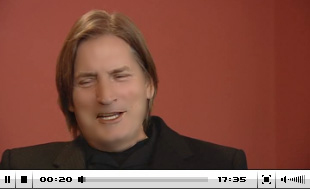(to February 2009)
Pierre Bergé pulls Andy Warhol portraits from Grand Palais show
Yves St. Laurent's partner Pierre Bergé has removed four Andy Warhol portraits of Yves St. Laurent from the "Le grand Monde d'Andy Warhol" exhibition opening on March 18, 2008 at the Grand Palais in Paris.
Bergé, who co-founded the Yves Saint Laurent Couture House with the designer in 1961, objected to the placement of the portraits in the "glamour" section of the exhibition. AFP is quoting Bergé as saying, "I don't think Yves Saint Laurent comes under the category of 'glamour.'" (This is despite the fact that St. Laurent's work was previously included in an exhibition devoted to glamour - "Glamour: Fashion, Industrial Design, Architecture" - at the San Francisco Museum of Modern Art in 2004/5.)
In regard to the Grand Palais exhibition, Berge explains, "I told the curator I did not see things this way, either he changed Saint Laurent's place or I would withdraw the paintings. Apparently this was not possible for one reason or another and so I withdrew the four works... I don't deny he [YSL] was a designer, that was how he described himself, but I think he was more than that."
Andy Warhol, Jonas Mekas, Ken Jacobs, Ron Rice and Joseph Cornell films on Treasures IV
Treasures IV: American Avant-Garde Film, 1947-1986: Treasures from the American Film Archives - a 2 DVD set to be released on March 3, 2009 - includes Andy Warhol's Mario Banana (No. 1) (featuring Mario Montez); Ken Jacobs' Little Stabs at Happiness (featuring Jack Smith) ; Ron Rice's Chumlum (also with Jack Smith); Stan Brakhage's The Riddle of Lumen; Joseph Cornell's By Night with Torch and Spear; Jonas Mekas' Notes on the Circus, Marie Menken's Go! Go! Go! as well as films by Bruce Baillie, Wallace Berman, Shirley Clarke, George Kuchar and others.
Also included is newly recorded music by John Zorn, a 70-page book of program notes with a foreword by Martin Scorsese and 2 postcards.
Ray Johnson: Raven Row: 28 February - 10 May 2009
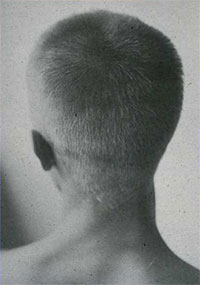
Ray Johnson
(Photo: Hazel Larson Archer)
Details of the Ray Johnson exhibition, "Ray Johnson. Please Add to & Return," at Raven Row in London can be found here.
Donna de Salvo:
“… Johnson’s experiments with collage were distinctive. A comparison between his work and that of Rauschenberg is particularly illuminating in this regard. In spite of the great similarities between Rauschenberg’s and Johnson’s work, the two took the medium of collage as an organizing principle for their production in radically different directions. As Charles Stuckey has written, Rauschenberg’s ‘art of the parts’ was deeply antithetical to the Abstract Expressionist conception of the pictorial surface as a unified whole; the same could be said of Johnson’s. Yet, in addition, the work of both artists reveals an essentially formalist concern with structure, as well as a simultaneous tendency to invest structure with elements of the personal and autobiographical. Both artists also desired to work in what Rauschenberg described as the gap between art and life, evolving formal devices that engaged and acknowledged the spectator. But if collage was an essential element in Rauschenberg’s Combines, as well as in the equally revolutionary development of Johnson’s correspondence art, herein lies an important difference between the two artists. Rauschenberg’s Combines were made primarily for the context of the gallery and the museum, while Johnson has been described as ‘the master of collage on a portable scale.’ Johnson’s radical contribution was to expand the compositional network beyond the confines of a single collage and take it to the world. If Rauschenberg introduced life into art, Johnson introduced art into life.” (Donna de Salvo, Ray Johnson: Correspondences (Paris: Flammarion, 1999), p. 18-19)
Hilton Kramer:
"We [Kramer and Johnson] met at a party at a friend's house on the Upper East Side of Manhattan in the winter of 1952-53. Like Ray, most of the other guests at that party were alumni of Black Mountain College in Asheville, N.C., where they studied with Josef Albers and also came under the influence of John Cage. Until then, Black Mountain had been little more than a legend to me – a legend compounded of stories about unorthodox experiments in the arts and equally unorthodox experiments in living. It didn't take long to understand that Black Mountain had, for better or for worse, left a deep imprint on the lives of everyone who had been there. This was certainly true of Ray, whose art cannot be fully understood, I think, in isolation from the ideas of both Albers and Cage. Yet what most impressed me about Ray at the time was that despite his apparently sunny disposition and his extraordinary good looks, he already sounded like a man in mourning for his life. (He was then in his mid-20's.) He had clearly adored Black Mountain, but he spoke of it as a paradise from which he had now been exiled into a world he didn't especially like. There was already a note of unappeasable nostalgia, regret and refusal in everything he said. It made a great impression on me at the time because just about everyone else at that party – myself included – was in a state of high excitement about the New York art scene and eager to become a part of it. Ray, on the other hand, seemed already to be preparing to drop out.” (Hilton Kramer, "The Sadness of Ray Johnson in Big New Whitney Show," The New York Observer (February 7, 1999))
Carol Vogel:
"Ray Johnson... a pioneer in using images from popular culture, died on Friday in Sag Harbor, L.I. He was 67 and lived in Locust Valley, L.I. A spokesman for the Sag Harbor Police Department said that Mr. Johnson checked into the Baron's Cove Inn in Sag Harbor on Friday afternoon and either fell or jumped from the Sag Harbor-North Haven bridge that evening…
Raymond E. Johnson was born in Detroit and went to Black Mountain College in North Carolina, where he studied with Josef Albers and Robert Motherwell… Besides being one of the earliest Pop artists, Mr. Johnson became known for creating whimsical works known as "mail art," art created out of scraps of correspondence. In 1968, he founded the New York Correspondence School, an international postal network whose members exchanged works and objects through the mail. Like Joseph Cornell's work, Mr. Johnson's art combined deadpan relief drawing, painting, lettering and found objects as well as abstract mosaic elements…”
(Carol Vogel, Ray Johnson, 67, Pop Artist Known for His Work in Collage, The New York Times (January 19, 1995))James Rosenquist:
"I was introduced to Bob Rauschenberg through Ray in 1956, and later I met Lenore Tawney and Agnes Martin through Ray. The first time I visited Joseph Cornell, there was Andy Warhol and Ray and Bob Indiana.
Then Ray moved to Locust Valley. He sent me things in the mail to send on to other people, and when they were really beautiful I'd keep them. Usually they were funny, bizarre, very mysterious, beautiful things -- collages. Once he sent me an image of Bill de Kooning's bicycle seat. And he'd say, ''Finish this portrait.'' So I'd finish it, and send it on. Things like that I thought I could understand, it was ironic and deep and funny. It was also a very delicate vision. Ray's work has a different kind of feeling than, say, Roy Lichtenstein's or Andy Warhol's or mine. It was a much more personal, private experience, a discovery kind of thing, not smack dab in your face. He would say, ''This weekend I walked to all the mailboxes in Brooklyn.'' He had probably put things in them. He would do that, it seemed to me, a little bit like Zen: if you think you know something, you realize you don't know it; then, when you realize you don't know anything, something pops into your head and your mind learns something. I miss Ray, because whenever I find something that is really bizarre, I don't have anyone to send it to."
("Dear Friends of Ray, and Audiences of One," The New York Times (February 28, 1999))
D'Offay Warhols in Walsall and Wolverhampton
Two Warhol exhibitions of works that were part of the Anthony d'Offay collection acquired by the Tate and Scottish National Gallery last year will be exhibited in Wolverhampton and Walsall during 2009 - part of a series of 20 exhibitions of works by various artists from the collection that will take place throughout the U.K. The Financial Times notes "Anne and Anthony d’Offay’s unparalleled international collection of modern and contemporary art is about to go public in a series of 20 exhibitions to be staged up and down Britain, transforming the visual arts landscape of the country. Comprising more than 700 works valued at £125m, the d’Offay collection was acquired for the nation by Tate and the Scottish National Gallery last year for the knock-down price of £26.5m. It is the most lavish gift of art made to the UK in a century, putting d’Offay on a par with philanthropists Henry Tate and Samuel Courtauld."
Warhol's drawings will be exhibited at The New Art Gallery Walsall from May 15, 2009 to July 5, 2009 and consists of 50 early Andy Warhol works on paper dating from 1950s - 1962 and four later drawings. Details here.
"Andy Warhol Paintings, Posters and Screenprints" which includes Skulls (1976), Self-Portrait (Strangulation) (1978), Camouflage (1986) in addition to portraits and posters of Man Ray (1967), Mick Jagger (1980), Gilbert and George (1975), and Muhammad Ali (1978), will take place at the Wolverhampton Art Gallery from March 28, 2009 to September 21, 2009. Details at: here.
Louis Waldon exhibition at The Grind Gallery in California
Warhol star Louis Waldon currently has an exhibition at The Grind Gallery in Mar Vista, California which runs until March 20, 2009. Waldon uses Warhol's imagery to create his own silkscreens. According to Waldon, "You can't tell the difference... They look better. Andy didn't really know what he was doing." (CL)
Films that Waldon appeared in included Nude Restaurant (with Allen Midgette); Flesh (with Joe Dallesandro); Lonesome Cowboys (with Eric Emerson) and Blue Movie (with Viva). The press release for his art exhibition also mentions films referred to as "The Bizarre Ones" and "Keeping Busy."
From the press release:
"Louis Waldon began his theater career in San Francisco. Eventually he moved to New York where he worked as a legitimate actor on Broadway. After seeing Waldon perform, Andy Warhol recruited him to appear in several of his avant garde films (Nude Restaurant 1967, The Bizarre Ones 1968, Flesh 1968, Keeping Busy 1969, Lonesome Cowboys 1969 and most notably Blue Movie 1969), thrusting him into the Silver Factory’s most creative & productive years.. During those years Louie was also actively involved in the fabrication of Andy’s work, most notably Warhol’s silkscreened images that ran the range from seductive Hollywood icons to disasters that in and of themselves were too painful to look at, but like a real disaster, too hard to look away.
Louie remained at the Factory til Warhol’s unexpected death in 1987. Settling in Hollywood he began producing work in the tradition of Andy Warhol... Louis uses the same techniques that Warhol used in the Factory during the sixties. All the works are limited editions of 80. They are numbered and stamped “Andy Warhol Superstar Years” and signed by Louis Waldon."
Details here.
Mary Harron masterclass at the ICA London
Mary Harron, the director of I Shot Andy Warhol, will be conducting a masterclass at the ICA in London on March 7, 2009.
Details here.
Trash in London
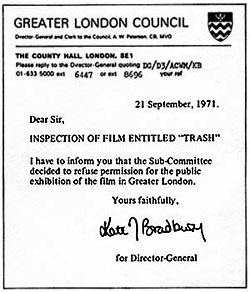
I have added to the site an account of the censorship problems with Paul Morrissey's film, Trash, when Vaughan Films attempted to release it commercially in the U.K. The account appeared in the original U.K. program brochure for the film. "Swinging" London wasn't quite as swinging as is sometimes suggested. Unlike in the states where pornography proliferated during the 60s and 70s, the English remained fairly conservative about it. Two scenes from Trash had to be cut to get censorship approval - the scene in which Holly Woodlawn has sex with a beer bottle and the scene where Geri Miller performs oral sex on Joe Dallesandro.
The account of the struggle to get the censors to approve Trash in the U.K. can be found here.
Joe Dallesandro interview
An interview with Joe Dallesandro (star of Paul Morrissey's Flesh, Trash and Heat), filmed at the Berlin International Film Festival where Joe was recently given a special "Teddy" award, can be found here.
Brigid Berlin "Trip Book" to be auctioned in March
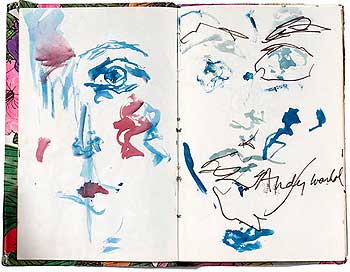
One of Brigid Berlin’s “trip” books is to be auctioned at Cowan’s Auctions in Cincinnati during their American and European Paintings Sale that begins on March 12, 2009.
The book consists of approximately 200 pages of watercolor, ink, stamps, graphite and mixed media, including sketches of individuals within Warhol’s circle. It has an auction estimate of $8-12,000. Another trip book of Brigid's, her infamous "Cock Book," was sold several years ago to the artist Richard Prince for $175,000.
Auction details here.
Happy Birthday Doric Wilson
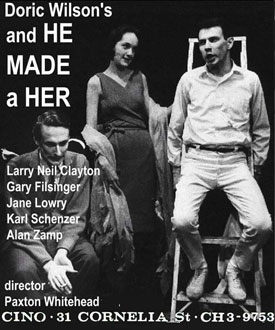
The 70th birthday of Caffe Cino playwright and TOSOS co-founder, Doric Wilson, will be celebrated on Tuesday evening (after 9:00 pm) at Zuni's - 598 9th Ave @ West 43rd Street - the far back corner - no host bar.
Upcoming TOSOS shows include Ethyl Eichelberger's solo show project, Doric Wilson's Forever After (directed by Mark Finley), and a revue of songs of the late John Wallowitch by Mark Finley. (Wallowitch was the brother of Andy Warhol's lover, Edward Wallowitch.) More on TOSOS at: here.
More on the Caffe Cino at: here.
Pop: The Genius of Andy Warhol to be published in October 2009
Amazon is listing Tony Scherman and David Dalton as the authors of a 500+ page book called Pop: The Genius of Andy Warhol to be published by "Harper" on October 27, 2009. Although Scherman was researching a Warhol book about five years ago, it's unclear whether this is that book or possibly a a compilation of writings from various authors about the artist. Co-writer David Dalton is the brother of Sarah Dalton who edited Andy Warhol's Sleep and has previously written text for several Warhol books including Edie Factory Girl (with photos by Nat Finkelstein) and A Year in the Life of Andy Warhol (with photos by David McCabe).
My sister Sarah and I first met Andy Warhol at a commercial artist’s hipster Christmas party in 1961. In those days Andy worked in his house at 1342 Lexington Ave. The entranceway was like the witch’s house in Hansel and Gretel: pinball machines, wooden cigar-store Indians, soda pop signs... Andy moved into the Factory, a commercial loft on East 47th Street in 1964... The requirements for admission to the Factory club of deviants and drugs addicts - I’m still in touch with the little monsters - was that you had to be gay and shoot speed. That seemed a little steep, and by then my sister and I were in college. We still came by the Factory often, though, to see Andy...
Further details on Pop: The Genius of Andy Warhol will be posted here once known.
Richard Polsky sold Andy Warhol too soon (or did he?)
Richard Polsky, author of I Bought Andy Warhol, will be bringing out a new book - I Sold Andy Warhol (Too Soon) on September 15, 2009. In Polsky's new book he sells the Andy Warhol "fright wig" Self-Portrait that he purchased in the first book. Once the owner of the San Francisco gallery, Acme, Polsky is now an independent art dealer who writes for Artnet.
to February news
